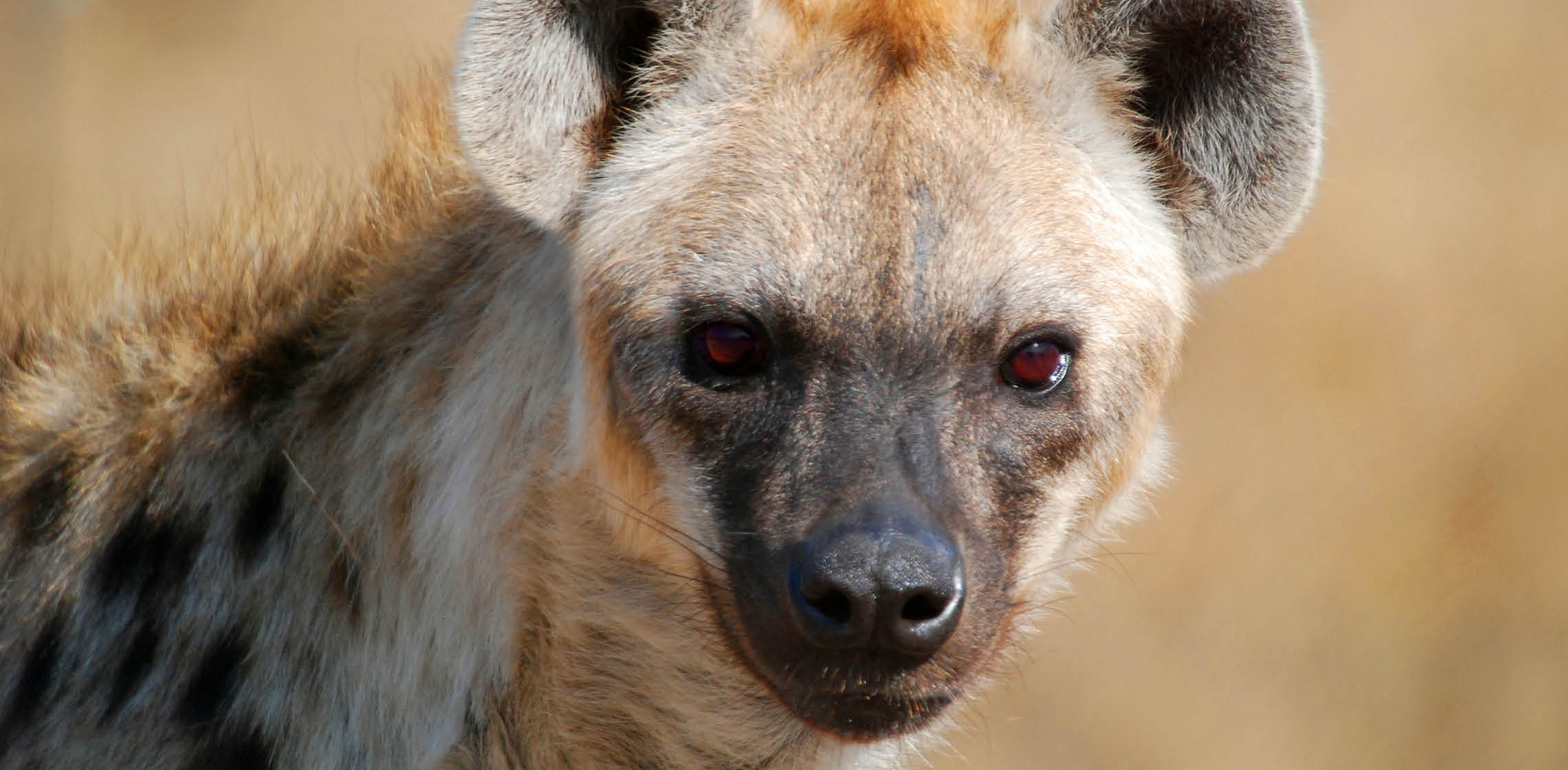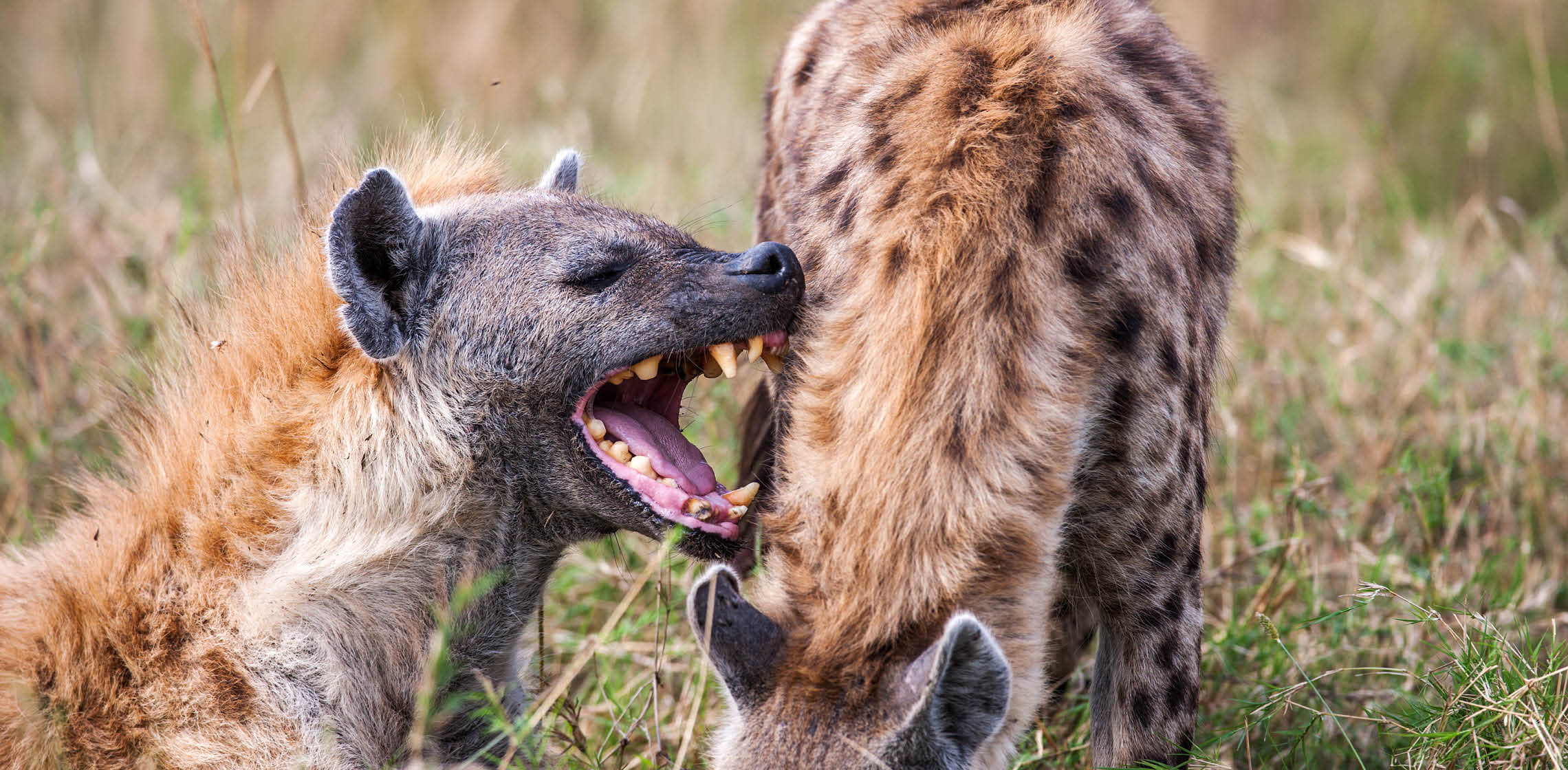Location in Zoo
Geographic Range
Scientific Information
Lifestyle and Lifespan
Conservation

Hyenas are well known for the variety of vocal communication they use. Groans and soft squeals are emitted during hyena greetings. A whoop is used as a contact call in addition to a fast whoop which is used by excited hyenas at a kill. In addition, hyenas give several calls related to aggression. These include grunting, giggling, growling, yelling, and a rattling growl. These calls are given in a variety of aggressive interactions with clan members, other clans, or other species. The giggling is the signature "laughing" call of the hyena. It is associated with fear or excitement and is often given when an individual is being chased. In addition to vocal communication, Spotted Hyenas go through elaborate greeting ceremonies involving a lengthy genital inspection. Chemical communication also occurs due to common latrine areas, and scent marking.
This is the largest of the three hyena species. They have a sturdy build, long neck, high shoulders, and long muscular legs, with the forelegs longer than hind legs and four toes on each foot with non-retractile claws. The head is massive with rounded ears and robust teeth adapted for chewing bones. The coat is rough, comparatively short, and ranges in color from reddish-brown to tan, growing lighter and less spotted with age. Spots are black and rounded. Tail tip, muzzle and lower parts of limbs are dark brown. A slight mane may be present on neck and shoulder. Uses an ambling walk or a tireless lope, and can gallop up to 31 miles an hour for a couple of miles (top speed 37 mph).
The jaws are probably the strongest in relation to size of any mammal, helping hyenas to utilize virtually everything on a carcass except the rumen contents and horn bosses. The front legs are longer than the hind legs, which gives the back of Spotted Hyenas a slightly odd, downward slope. The feet have four digits with short, non-retractable claws and broad toe pads. C. crocuta females are extremely masculinized and the genitalia of females are almost indistinguishable from those of males. The clitoris is enlarged, looks like a penis, and is capable of erection. Females also have a pair of sacs in the genital region which are filled with fibrous tissue. These look much like a scrotum, but are covered with more hair than the male's scrotum. Thus, males and females look extremely similar. The female has no external vagina and must urinate, mate, and deliver young through the urogenital canal that exits through the pseudo-penis. One current hypothesis is that sexual mimicry is the driving force behind hyena masculinization. Females that look like males may be protected from aggression from other females.

Open, dry habitat including semi-desert, savanna, acacia bush, and mountainous forest
Until very recently, spotted hyenas were a common species in most of sub-Saharan Africa. Since 1970, confirmed records of C. crocuta have been recorded in Tanzania, Kenya, Zambia, Zimbabwe, Mozambique, South Africa, Botswana, Namibia, Congo, Sudan, Central African Republic, Cameroon, Nigeria, Burkina Faso, Ivory Coast, Mali, Senegal, and Sierra Leone. Hyenas occur throughout sub-Saharan Africa, but their density varies widely across this area. They have been extirpated from most areas of South Africa. High densities occur in the Serengeti and especially the Ngorongoro crater in Tanzania. Crocuta crocuta is the most numerous large predator in the Serengeti.
Birds, mammals, fish, eggs, carrion, terrestrial non-insect arthropods. Common prey items include wildebeest, zebra, gazelle, buffalo, and warthogs. They sometimes feed on the young of giraffes, hippopotamus, and rhinoceros.
Hyenas are the most numerous large predator in Africa in areas where ungulates are common. Thus, they are an extremely important component of this ecosystem. Hyenas utilize almost every part of their prey except for horns and rumen, and scavenge often. As scavengers, they help break down organic material, and keep their range free of dead bodies. As top predators, they help keep the populations of prey animals from becoming too numerous.

Spotted Hyenas live in clans composed of 3 to 80 members. Larger clans generally occur in prime territory with large prey concentrations, whereas smaller clans occur in desert areas in southern Africa. All females are dominant to all males, and females will remain in their natal clan for their entire lives. Males disperse when they reach sexual maturity to join other clans. Once a male joins another clan, he enters a dominance queue. When older males die, newer males will move up the social ranks. Although Spotted Hyenas live in clans, the members are usually only observed together when defending territory, hunting, or caring for young at a communal den. More often, the clan members forage alone or in small groups.
Spotted Hyenas are highly polygynous and mate year round. Males perform a bowing display to females before mating. The male lowers his muzzle to the ground, advances quickly toward the female, bows again, and then paws the ground close behind the female. Because the females are dominant, males will retreat immediately if the female shows any aggression.
Females usually bear twins although 1 to 4 young are possible. Females are capable of producing a litter every 11 to 21 months. The newborns weigh from 2 to 4 lbs and are born with their eyes open. Newborns are almost entirely black. If siblings are the same sex, they begin fighting violently soon after birth, which usually results in the death of one of the two. Because single young receive more food and mature faster, this behavior is probably adaptive. Two to six weeks after birth, the mother transports young from the burrow in which they were born, often an abandoned aardvark, warthog or bat-eared fox burrow, to a communal den. Although the hyenas will den communally during this period, they do not provide communal care for the young. Cubs are not weaned until they are between 14 and 16 months of age. Males play no role in caring for young. High ranking female hyenas seem to preferentially give birth to sons. Infanticide has been witnessed several times in the wild both by hyenas from neighboring clans and also by females from the same clan.

Listed as Least Concern by the IUCN, as the species remains widespread in Africa, and the total world population well exceeds 10,000 mature individuals. There is a continuing decline in populations outside protected areas due to persecution and habitat loss, although this is not sufficient to warrant listing in a threatened category.
Through the end of the Pleistocene, spotted hyenas, Crocuta crocuta, ranged throughout Eurasia, but the reasons for its extinction there are not certain

Spotted Hyena droppings are white in color.